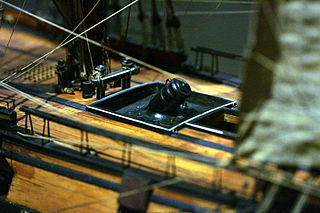
Bomb vessels served in the Royal Navy over a period of about 150 years. The concept entered the Navy in the 1680s, based on French designs and usage, and remained in service until the mid-19th century. [1] Bomb vessels were designed to bombard enemy positions on land, such as towns and fortresses. For this they were fitted with one or two mortars that could fire high-trajectory shells over considerable distances. [1] They were fleet support units, and as such were not intended to engage enemy ships directly except in self-defence, and so received only light conventional armament. [1] They could also carry explosive shells in addition to regular shot, and were the only ships in the navy so equipped. [1] The first designs tended to be ketch-rigged, to allow the mortars to fire forward. Though effective, this arrangement made for poor sailing qualities and by 1790 the ship rig had replaced the ketch. [1]
Contents
- 1687–1729
- Early designs
- Purpose-built
- Purchased vessels
- Prizes
- Converted vessels
- 1730–1783
- Purpose-built 2
- Converted sloops
- 1784–1840
- Purpose-built 3
- Purchased vessels 2
- Ex-Dutch prize
- Converted vessels 2
- Mortar frigates, vessels and floats (1850s)
- Mortar frigates
- Mortar vessels
- Mortar floats
- Notes
- References
While the Navy introduced several purpose-built classes and single ship designs, it augmented this during wartime by buying and converting merchant vessels, or converting some of its own warships. [1] Bomb vessels tended to have a consistent naming policy, being names of volcanoes, or those in some way linked with the concept of hell and fire. [1] Examples included Blast, Furnace, Explosion, Fury, Aetna and Vesuvius. [2] The names were re-used several times for different bomb vessels over the decades. Bomb vessels played a significant role in several of the battles fought by the Royal Navy, being deployed to threaten the Danish capital at the Battle of Copenhagen in 1801, actually firing on the city in 1807, playing a distinctive role in the 1814 Battle of Baltimore, and firing on enemy positions during the Bombardment of Algiers in 1816. Bomb vessels went on to serve in other fields as well. Their sturdy design to resist the recoil of their mortars made them desirable ships for polar exploration, as their hulls could resist the pressure of the ice for longer. [3] Racehorse, Furnace, Carcass, Fury, Hecla, Erebus and Terror, among others, all went on to serve as exploration vessels. [4]
Eventually, the Royal Navy began to phase out the concept. The last bomb-ship to serve with the Royal Navy was Sulphur, which had been converted to a survey ship in 1835 and then a receiving ship in 1843 before finally being broken up in 1857. [5] The concept was revisited in a modified form during the Crimean War but on a considerably smaller scale. [6]





